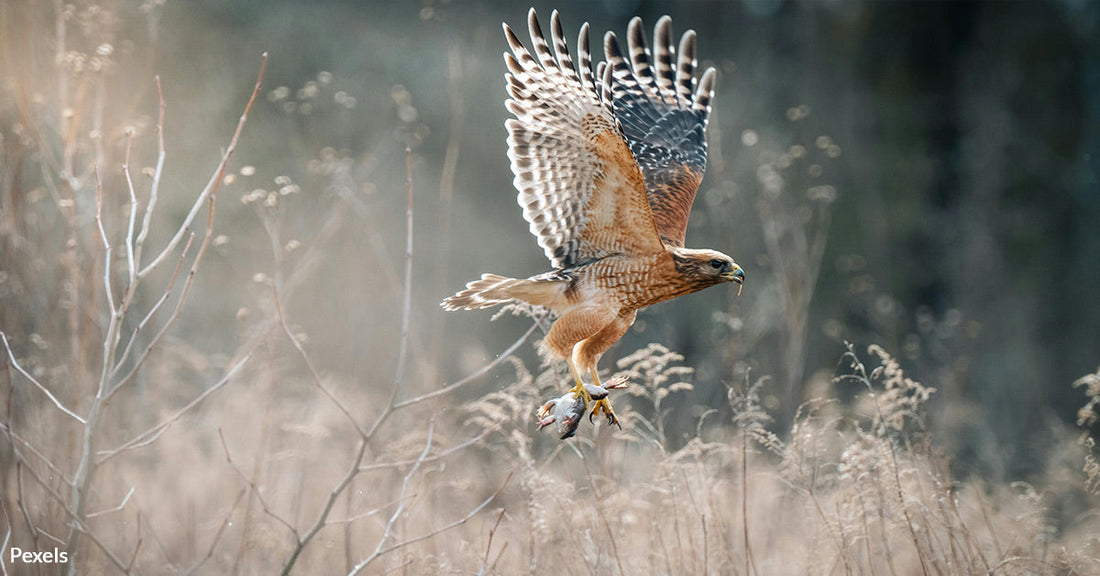Illegal Shooting Destroys America’s Majestic Birds More Than Electrocution
Matthew Russell
Photo: Pexels
North American raptors face a threat that is more deadly than electrocution. New studies reveal that poaching is taking a heavier toll on eagles, hawks, and other birds of prey. Research spanning multiple states now shows that illegal gunshots claim more lives than accidental contact with power lines. The findings come from detailed investigations and fieldwork conducted over 4 years.
Field teams collected 410 carcasses along 120 miles of power lines in Idaho, Oregon, Wyoming, and Utah. Radiographs and forensic tests indicated that most raptors had been shot rather than killed by electrocution. In many cases, gunshot wounds were evident, with birds showing multiple embedded pellets, Central Oregon Daily News reports.
This disturbing trend has shifted the focus of conservationists who once worried mostly about power infrastructure. The reality on the ground is grim.

Photo: Pexels
Poaching kills more raptors than electrocution in the West.
Unmasking the True Killer
At first glance, electrocution and gunshot injuries can look similar. Both result in severe trauma and rapid decline. However, experts point out clear differences. At the Blue Mountain Wildlife Center in Pendleton, a red-tailed hawk arrived with what was assumed to be electrocution injuries. Upon closer inspection using an X-ray, wildlife professionals discovered 16 gunshot pellets lodged throughout the bird's body.
“We thought the bird was electrocuted at first,” Lynn Tomkins, the center’s Executive Director, told KDRV. “The X-ray told a different story.”
Utility companies have long worked to reduce electrocution. Since the 1970s, measures such as insulated wires and safe nesting structures have helped lower accidental deaths. Yet, these same structures provide convenient perches for raptors. As NBC Right Now reports, poachers target these birds, often under the cover of darkness. The evidence shows that illegal shooting is more frequent than previously assumed.

Photo: Pexels
Illegal shooting ends a bird’s ability to fly.
The Human Cost of Illegal Shooting
The grim statistics are backed by personal stories and hard evidence. Poachers kill for various reasons, ranging from thrill killing to the illegal trade of raptor parts. Protected species such as golden eagles, which hold cultural significance for many Native American tribes, are particularly at risk. U.S. law prohibits the killing of these birds without proper permits. Despite these regulations, a thriving black market persists. One case, reported by Central Oregon Daily News, detailed a Montana resident sentenced to four years in prison and ordered to pay over $700,000 in restitution for his role in a trafficking ring that had targeted hundreds of raptors over decades.
Reports indicate that poaching now ranks as the second leading cause of death for golden eagles, just behind poisoning. This stark reality calls for enhanced efforts in wildlife protection and law enforcement.
“Poaching affects all wildlife in Oregon, including precious animals like raptors,” Danielle Moser, Wildlife Program Manager for Oregon Wild, told Columbia Basin Bulletin.

Photo: Pexels
Golden eagles suffer high mortality from poaching.
The Urgent Need for Change
The fate of North American raptors now hangs by a thread. The loss of a single raptor can have a ripple effect on entire ecosystems. These apex predators help maintain the balance of nature, and their absence could lead to unforeseen consequences in the food chain.
Authorities and experts warn that if poaching continues unchecked, the impact will be felt far beyond the immediate loss of birds.
The future of these magnificent birds depends on a united effort to confront poaching head-on. With a concerted approach involving research, community reporting, and tougher legal measures, there is hope for a future where these birds can thrive free from the threat of illegal gunfire.
Matthew Russell is a West Michigan native and with a background in journalism, data analysis, cartography and design thinking. He likes to learn new things and solve old problems whenever possible, and enjoys bicycling, spending time with his daughters, and coffee.
